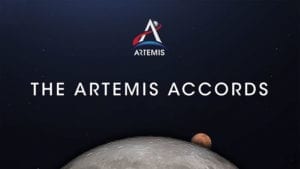by Antonino Salmeri
 On October 13th 2020, at the occasion of the 71st International Astronautical Congress, a coalition of 8 Countries including Australia, Canada, Italy, Japan, Luxembourg, the United Arab Emirates, the United Kingdom and the United States of America presented a multilateral document called “The Artemis Accords”.[1] Legally, the Artemis Accords constitute a political commitment towards certain “Principles for Cooperation in the Civil Exploration and Use of the Moon, Mars, Comets and Asteroids for Peaceful Purposes”[2]. Politically, the Accords aim to “operationalize” the norms of the Outer Space Treaty for the development and execution of the Artemis Program. [3] Unsurprisingly, this announcement has raised both appreciation and scepticism, with some States considering to sign the document and some others criticising the process as “too US- centric”.[4] In parallel, the space law community has started to discuss the legal and policy impact of the Accords, with eminent colleagues either speaking in their support or calling for more cautiousness.[5] In this context, this article focuses on the principle of interoperability described in Section 5 of the Accords, discussing its implications on the future of space exploration.
On October 13th 2020, at the occasion of the 71st International Astronautical Congress, a coalition of 8 Countries including Australia, Canada, Italy, Japan, Luxembourg, the United Arab Emirates, the United Kingdom and the United States of America presented a multilateral document called “The Artemis Accords”.[1] Legally, the Artemis Accords constitute a political commitment towards certain “Principles for Cooperation in the Civil Exploration and Use of the Moon, Mars, Comets and Asteroids for Peaceful Purposes”[2]. Politically, the Accords aim to “operationalize” the norms of the Outer Space Treaty for the development and execution of the Artemis Program. [3] Unsurprisingly, this announcement has raised both appreciation and scepticism, with some States considering to sign the document and some others criticising the process as “too US- centric”.[4] In parallel, the space law community has started to discuss the legal and policy impact of the Accords, with eminent colleagues either speaking in their support or calling for more cautiousness.[5] In this context, this article focuses on the principle of interoperability described in Section 5 of the Accords, discussing its implications on the future of space exploration.
Simply put, interoperability is the “ability of a system to work with or use the parts or equipment of another system”[6] and is a relatively new concept for the space industry. Until the development and operation of the International Space Station (ISS), there was no need to include interoperability within space systems, simply because almost all of them were not meant to function for third parties. However, both the modular structure of the ISS and the need to work with a pool of diverse international astronauts and experiments soon revealed the fundamental importance of interoperability for the future of space exploration. Power systems, communication devices, robotics and docking are just some of the fields in which the ISS partners have started to develop interoperable standards, with the goal of facilitating daily operations on the station.[7] Unfortunately, despite the positive efforts carried out by the ISS partners, the fact remains that the station was not designed to be fully interoperable. As a consequence, there will always be an inherent limit to the degree of interoperability that can be achieved on board the station.
Learning from the ISS experience, Section 5 of the Accords recognizes that “the development of interoperable and common exploration infrastructure and standards […] will enhance space-based exploration, scientific discovery and commercial utilization”.[8] Therefore, the Accords commit the Signatories “to use reasonable efforts to utilize current interoperability standards for space-based infrastructure, to establish such standards when current standards do not exist or are inadequate, and to follow such standards”. [9] Looking at its wording, object and purpose, Section 5 has the potential to start a Copernican revolution in space exploration. The use of the expression “interoperable and common exploration infrastructure and standards” seems to imply the possibility of developing and using internationally shared facilities for joint exploration activities. Following this logic, instead of establishing multiple lunar bases each with its own fundamental systems and infrastructures (landing, power, communication, and so on), the Artemis Partners would integrate their different contributions to the program for the incremental development of a shared outpost. In turn, this would significantly reduce the costs of the Artemis program by avoiding unnecessary duplications of efforts and further minimizing the risk of harmful interference among the Partners’ activities.
Besides its effects on the Artemis Program, the concept of interoperability promoted in Section 5 of the Accords can also play an important role for the general long-term sustainability of space activities, should the international community decide to leverage it.[10] In this respect, it should be noted that the development and use of interoperable and common exploration infrastructure goes hand in hand with the UN Guidelines for the Long-Term Sustainability of Outer Space Activities.[11] This practice would in fact directly implement Guidelines C.1 and D.1.3, respectively calling for the “exchange of equipment for space activities” and “the development of technologies maximizing the reusability or repurposing of space assets”. Further, a shared lunar outpost welcoming contributions from international partners would “encourage the participation of developing countries” and “avoid unnecessary duplication of function and efforts”, implementing Guidelines D1.5 and C.3.3 and significantly contributing to the sustainable development of the Moon. Looking at these Guidelines, it seems clear that the idea behind Section 5 of the Accords is much broader than the Artemis Program, and that its importance goes beyond the political commitment of the Artemis Signatories. Regardless the debate on the Accords, there can be no sustainability if lunar exploration is conducted in silos. Thus, all space actors should prioritize interoperability as a key component of their lunar missions.
 On top of promoting sustainability, the development and use of common lunar infrastructure would also significantly reduce entry barriers for emerging space players, consequently fostering the exploration and use of the Moon as “the province of all humankind”.[12] In this respect, Section 5 of the Accords seems to be quite aligned with the European Space Agency (ESA)’s vision of a Moon Village[13] as “an environment where both international cooperation and the commercialization of space can thrive”.[14] The development and use of common infrastructure would translate this ambitious vision in reality and reinforce the traditional synergy between US and European approaches to space exploration, as showed by the recent agreement on the Lunar Gateway.[15]
On top of promoting sustainability, the development and use of common lunar infrastructure would also significantly reduce entry barriers for emerging space players, consequently fostering the exploration and use of the Moon as “the province of all humankind”.[12] In this respect, Section 5 of the Accords seems to be quite aligned with the European Space Agency (ESA)’s vision of a Moon Village[13] as “an environment where both international cooperation and the commercialization of space can thrive”.[14] The development and use of common infrastructure would translate this ambitious vision in reality and reinforce the traditional synergy between US and European approaches to space exploration, as showed by the recent agreement on the Lunar Gateway.[15]
Looking at Section 5 of the Accords from the viewpoint of international space law, the development of interoperable and common exploration infrastructure and standards seems to be very much aligned also with many fundamental principles of the OST. [16] To begin with Article I OST, one may argue that interoperability in itself is in the interest and for the benefit of all Countries, given that in principle every actor could benefit from its implementation. Likewise, because interoperability fosters contributions from international players at all levels of financial and technological development, this practice would slightly reduce discrimination and promote substantive equality in space activities. On the same line of reasoning, international cooperation for the development and use of a shared lunar outpost would prevent the national appropriation of celestial bodies and guarantee their exploration and use for exclusively peaceful purposes, in compliance with Articles II, III and IV OST. Last but not least, interoperability as enshrined in Section 5 of the Accords seems to offer a pragmatic solution for the operationalization of Article IX OST. The development of shared standards and common infrastructure would in fact inherently pay due regard to the corresponding interests of all States, enabling their active participation in space exploration. Likewise, this practice could significantly minimize the risk of harmful interference by addressing the issue at the root, within the design of space systems.
Needless to say, the concept of interoperability under Section 5 of the Accords needs further elaboration, especially in light of its practical implementation. As already recognized in the first place by the Artemis Signatories,[17] these and other aspects have to be discussed with the space community at the multilateral level. In light of the various initiatives recently promoted to this end by many actors,[18] the time seems mature for the United Nations Committee on the Peaceful Uses of Outer Space (COPUOS) to consider new forms of international cooperation for sustainable and inclusive space exploration. As part of this process, it is of the utmost importance that COPUOS Members recognize the benefits of conducting not only multilateral but also multi–stakeholder discussions. Nowadays, States are not anymore the gravity centre around which all other actors orbit. To succeed in securing a prosperous future, the debate in COPUOS must take into account the perspective of all relevant stakeholders: commercial players, scientific entities, academic institutions, non-governmental organizations representing civil society, and last but not least the young generations.[19]
 In conclusion, there is no doubt that interoperability has the potential to change space exploration forever, and hopefully for the best. Learning from the experience of the ISS, Section 5 of the Artemis Accords recognizes the importance of this concept and makes it one of the crucial elements of the Artemis Program. Besides this particular program, and in line with the spirit of the LTS Guidelines, the development of interoperable and common exploration infrastructure and standards could enable a new era of sustainable and inclusive space activities for the benefit of all humankind. Leveraging multi-stakeholder contributions from space community, COPUOS Members are now presented with the opportunity to redefine and enhance international cooperation in the exploration and use of space. Should this succeed, then a safe, peaceful and prosperous future may actually be ahead of us after all.
In conclusion, there is no doubt that interoperability has the potential to change space exploration forever, and hopefully for the best. Learning from the experience of the ISS, Section 5 of the Artemis Accords recognizes the importance of this concept and makes it one of the crucial elements of the Artemis Program. Besides this particular program, and in line with the spirit of the LTS Guidelines, the development of interoperable and common exploration infrastructure and standards could enable a new era of sustainable and inclusive space activities for the benefit of all humankind. Leveraging multi-stakeholder contributions from space community, COPUOS Members are now presented with the opportunity to redefine and enhance international cooperation in the exploration and use of space. Should this succeed, then a safe, peaceful and prosperous future may actually be ahead of us after all.
[1] The Artemis Accords – Principles for Cooperation in the Civil Exploration and Use of the Moon, Mars, Comets, and Asteroids for Peaceful Purposes, available online (accessed October 2020).
[2] Ibidem.
[3] For more information on the Accords, see this briefing from the U.S. State Department (accessed October 2020).
[4] Russia has been the first one expressing these concerns, further reiterated by some European commentators criticizing the “divide and conquer” strategy behind bilateral negotiations with “selected” countries in Europe.
[5] For the first group, see Chris Johnson, A First Look at the Artemis Accords, available online (accessed October 2020); for the second, see Chris Newman, The Artemis Accords and Lunar Exploration- Revolution and Evolution, available online (accessed October 2020).
[6] See Interoperability under the Merriam-Webster Dictionary (accessed October 2020).
[7] See International Deep Space Standards (accessed October 2020).
[8] Artemis Accords, supra note 1.
[9] Ibidem.
[10] Adhering to the recent invite sent by the NASA Administrator: Jim Bridenstine, Shared Standards are a Vital Part of Future Space Exploration, available online (accessed October 2020).
[11] Guidelines for the Long Term Sustainability of Outer Space Activities, U.N. Doc. A/74/20, Annex II (20th August 2020)
[12] Article I, Treaty on Principles Governing the Activities of States in the Exploration and Use of Outer Space, Including the Moon and Other Celestial Bodies, entered into force Oct. 10, 1967, 18 U.S.T. 2410, 610 U.N.T.S. 205
[13] The Moon Village Concept sees a community of equals where each actor is welcome to improve and use the outpost in fair cooperation with the others.
[14] Tom Whipple, Space Chief Sets His Sights on European Moon Village, THE TIMES (June 20th 2015).
[15] Unveiled on the 29th of October by a joint ESA/NASA announcement (accessed October 2020).
[16] For a deeper analysis on this topic, see Antonino Salmeri, Developing and Managing Moon and Mars Settlements in accordance with International Space Law, Proceedings of the 71st International Astronautical Congress, available also online for all registered attendees of the Congress (accessed October 2020).
[17] Artemis Accords, supra note 1 at both the Preface and Sections 9.2, 10.4 and 11.6.
[18] Inter alia, in order of publication: “Building Blocks for the Development of an International Framework for Space Resources Activities”, published on the 12th of November 2019 by The Hague International Space Resources Governance Working Group, available online (accessed October 2020); “Vancouver Recommendations on Space Mining”, published on the 20th of April 2020 by the Outer Space Institute, available online (accessed October 2020); “Lunar Resources Policy”, published on the 7th of October 2020 by the Open Lunar Foundation, available online (accessed October 2020); “Best Practices for Sustainable Lunar Activities”, published on the 19th of October 2020 by the Moon Village Association, available online (accessed October 2020).
[19] As voiced by the Space Generation Advisory Council, which has recently entered the global debate on lunar exploration through the work of the T.U.R.T.L.E. Group and the E.A.G.L.E. Team.

Antonino Salmeri is a doctoral researcher in Space Law at the University of Luxembourg, where he is pursuing a PhD on enforcement challenges of space mining regulations under the supervision of Prof. Mahulena Hofmann and the support of the Luxembourg National Research Fund (FNR) (PRIDE17/12251371). Within the space community, Mr. Salmeri is Lead of both the E.A.G.L.E. Action Team on Lunar Governance and the Space Exploration Project Group for Space Generation Advisory Council, SSP19 graduate of the International Space University and member of the International Institute of Space Law. He can be contacted at: [email protected]
 SpaceWatch.Global An independent perspective on space
SpaceWatch.Global An independent perspective on space




